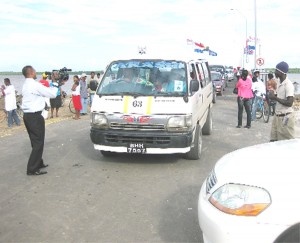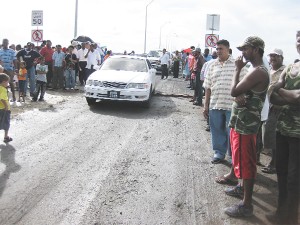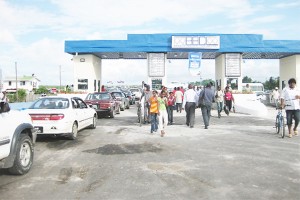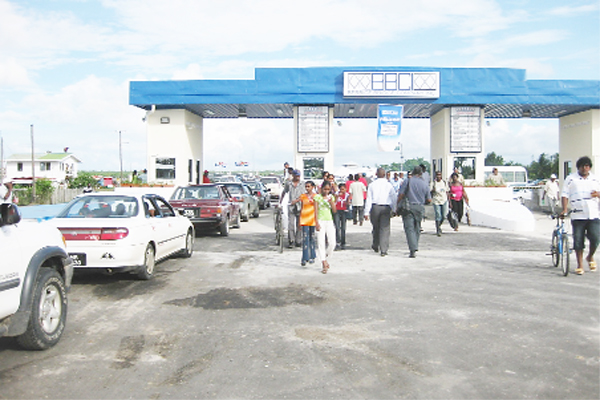A sixteen-year-old promise by the PPP/C government was delivered on yesterday when there was a limited opening of the bridge across the Berbice River and it was hailed as a motor for investment in the Ancient County and the end to crippling travel woes for commuters.

There was excitement in the air as members of the public got the opportunity to drive across the much talked-about bridge shortly after the 1 pm opening while many others choose to walk it.
It was their only chance to ever walk across as the structure as it is not equipped with a walkway so they wasted no time in doing so after President Bharrat Jagdeo and Chairman of the Berbice Bridge Company Inc. (BBCI), Geeta Singh-Knight cut the ribbon to declare it open.

Singh-Knight made the announcement that vehicles would be allowed to cross the bridge free for yesterday amid loud cheering from the gathering. The bridge was built by the consortium of Bosch Rexroth and Mabey & Johnson,
Throughout their journey across the bridge persons were calling their relatives on their cell phones to tell them they were actually walking on the floating structure. Many screamed in excitement and commented that they could not believe that “we finally deh pun de bridge.”
They told this newspaper that it felt “great to know that the bridge has finally become a reality” and some admitted that they are already saying “goodbye to the inefficient ferry service.”

They saw the opening as a welcome holiday gift and were happy that the government and the BBCI were able to deliver on their promise
At the short opening ceremony, Jagdeo alluded to the fact that persons suffered and had to “pay bribe” just to get across with the ferry.
Among those in attendance were Prime Minister Samuel Hinds and government ministers including Dr Ashni Singh, Dr Frank Anthony, Clement Rohee and Priya Manickchand.
The president said that apart from the bridge being convenient for persons it would help to save time and “encourage more investment and integrate the people of Region Six with the rest of the country.”
He said that it was not an easy road to get the project completed but that his party saw the bridge as an essential part of the development of the country.
He mentioned that the farmer from “Black Bush Polder” would no longer have to sell his produce to the middleman who, after getting the supplies on the ferry would eventually enjoy the profit at the market.
Schoolchildren too would be spared from suffering long delays to cross and would get home early for their studies. He also noted that the bridge would improve the lives of many other persons.
Jagdeo is relieved that when he visits Berbice he would no longer have to answer questions about when the bridge would be completed noting that he would have to deal instead with the question of the completion of the Skeldon Sugar Modernization Project.
The ferry, he said, would have to be kept going for passenger services and for trucks as the road is not finished as yet. He urged persons to have patience with the road and said that the opening was just done to facilitate persons for the holidays.
Asked to comment on the state of the road, Minister of Public Works, Robeson Benn said that while it is drivable more work has to be done to apply asphalt at the centre and at the Palmyra junction.
He was happy that the work was optimized to bring it to a point where vehicles could ride on the surface.
Meantime, Jagdeo said more roads would have to be built into the intermediate savannahs to bring more land into production. A deep water harbour which would cut the cost of freight is also needed, he said.
He added that there is a need to cut the cost and improve the reliability of electricity saying that was the reason for putting more emphasis on hydropower. He mentioned too that government needs to put in infrastructure such as fibre optic cables to slash the cost of bandwidth.
According to him the Berbice Bridge is one of a series of activities needed to move the country to the next level and he was pleased to be there at the opening.
He said the government has to deal with the private sector and even though government’s finances have improved tremendously because of prudent management, it still runs a fiscal deficit. The president said too that government does not have for budgetary resources to develop the infrastructure.
He mentioned that at the initial stages of the project there were many “naysayers” recalling that the Inter-American Development Bank (IDB) approved a loan of US$41M in November 1997 while the government built US$11M into the negotiation.
However he said the IDB was at first reluctant to give the loan saying instead that government should improve the ferry service but he responded to them that he saw that “as a waste of money…”
He said several times thereafter he travelled to Washington to prove that the bridge is important and that the Public/Private Partnership is the way forward.
The government identified six possible locations during a pre-feasibility study. A feasibility study costing cost more than US $1M was then conducted by one of the largest firms involved in bridges around the world.
He said three of the sites were studied with two options each – a fixed bridge or a concrete structure. The present site he said was found to be the only one that would give a 12% internal rate of return at that time.
He said too that there were a lot of comments from some “elements” that the government wanted to punish New Amsterdam by by-passing the town and positioning the bridge at the current location.
But he said the location was decided upon following the technical work that was used as a guide.
Tolls
Tolls would only be collected on the western side of the bridge but a mini toll station is also being erected on the eastern side. Vehicles would be allowed to cross up to the 40-tonne weight limit and trucks would have to be weighed and may be required to pay an extra toll, depending on their weight.
The toll for cars and minibuses has been fixed at $2,200 while for pickups it would be $4,000; no charge will be levied per passenger.
The toll was calculated on the basis of a formula intended to secure sufficient revenue to cover all operating and maintenance costs, the return on investment and repayment on financing.
Singh-Knight said the initial opening will not cater to goods vehicles and that a public notice will be issued at least a week before they are to be allowed to traverse the structure.
The US$40M floating bridge which is said to have a lifespan of over 30 years, encountered numerous delays, missed deadlines and other obstacles.
The most recent deadline for the completion was September but owing to a delay with the shipment of the retractor span it could not have been met.
The surface of the bridge is coated with an epoxy resin and then overlaid with calcined bauxite, making the bridge virtually skid free. Also, cameras will be placed strategically to detect speeding and according to Singh-Knight, those caught speeding will be fined and they could also be banned if they persist. The speed limit on the bridge is set at 50 kilometres per hour (30 miles per hour).
Security and traffic
With regard to concerns about security on the bridge, Commander of ‘B’ Division, Krishna Lekhraj that “there was an initial security assessment in relation to the greater movements of persons and vehicles and measures have already been worked out, especially on the approaches.”
He is aware that the bridge would be a medium for criminal activities and said that there is also support from the Coast Guard as well as from the Guyana Defence Force on the eastern side.
Meanwhile, Traffic Chief, Neil Semple told this newspaper that systems would have to be put in place to accommodate one-lane traffic on the eastern end until the road is completed.
He appealed to drivers to adhere to the speed limit as the law would be enforced with regards to speeding. The traffic chief said that cops would patrol on motorcycles at both ends of the bridge and on the outskirts.
BBCI’s six common shareholders are Colonial Life Insurance Company (CLICO), the NIS, the Hand in Hand Fire Insurance Company, Secure International Finance, Demerara Engineers & Contractors Limited (a subsidiary of DDL), and New GPC.
Other investors in the project are Republic Bank Limited, Guyana Bank for Trade and Industry, Citizen’s Bank, Demerara Bank, Bauxite Company of Guyana Inc (BCGI), Hand in Hand Trust Corporation, the Guyana Geology and Mines Commission (GGMC) and the New Building Society (NBS).
The company will hand over the bridge to the Government in 21 years. Engineer Bert Carter, a Board member, said that the bridge is the sixth longest floating bridge in the world at 1,570.719 metres and noted that the Demerara Harbour Bridge is the fourth longest of its kind in the world.

